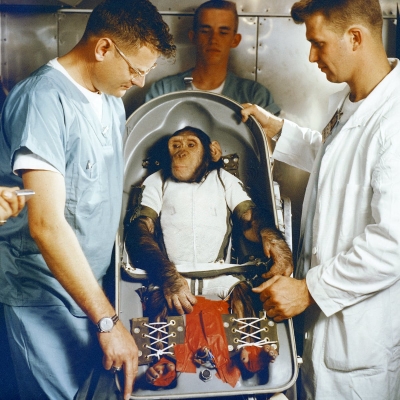
Hominids are any of a family (Hominidae) of erect bipedal primate mammals, including extinct ancestral forms. To put it simply, any member of a group that consists of humans, chimpanzees, gorillas and orangutans, or an early form of any one of these is known as a hominid. So while Americans Neil Armstrong and Buzz Aldrin remain the buzz words when we are talking about astronauts (as they were the first to land on the moon), and Soviet Union’s Yuri Gagarin was the first human ever in space, none of them can claim to be the first hominid in space.
That record goes to Ham, a chimpanzee. While other animals, including dogs, monkeys, mice, rabbit and fruit flies, had been sent to space from late in the 1940s, Ham became the first hominid when he achieved the feat on January 31, 1961.
Chimps turn astrochimps
Born in 1957 in the French Cameroons (now part of Cameroon) in West Africa, Ham was captured by trappers and the male chimpanzee was then sent to the Miami Rare Bird Farm in Florida, the U.S. He was sold to the U.S. Air Force in 1959, who then transferred him to Holloman Air Force Base in New Mexico.
Ham (after Holloman Aerospace Medical Center), who was merely “Number 65” at that time, was one among 40 chimpanzees chosen for the space programme that was to serve as the springboard for human spaceflight. The fact that both chimps and humans are hominids and that humans share more DNA with chimpanzees than any other animal meant that they were much more closely related, and hence chosen for the task.
The 40 chimpanzees chosen were put through the paces as they received their astrochimp training. They were taught to pull levers in response to light and sound and were awarded (with banana pellets) or punished (with mild electric shocks on their feet) based on their responses. Just like their human Mercury 7 counterparts who were training for years, these chimps too were subjected to g-forces and microgravity.
As the training progressed, the number of chimpanzees was first brought down to 18 and then to six – four females and two males. With their training complete, the Air Force sent the six finalists to Cape Canaveral in Florida on January 2, 1961.
The chosen one
The six were split into two groups of three in order to ensure that germs do not spread to everyone in case one of them became ill. The training sessions continued, and all six of them remained in contention until the day before the scheduled launch on January 31. Ham, who was said to be particularly feisty and in good humour, got the nod along with another female chimp, who served as backup.
Those traits probably served him well as Ham went to space aboard the Mercury spacecraft, boosted by a Mercury-Redstone 2 rocket. The flight didn’t go exactly as planned as the Mercury capsule unintentionally carried him to an altitude of 157 miles (252 km) and a speed of 5,857 mph (9,425 kmph) as opposed to the original targets of 115 miles (185 km) and 4,400 mph (7,081 kmph).
Ham experienced weightlessness for 6.6 minutes during his 16.5-minute flight. Even though there was a partial loss of air pressure as well, there was no damage done as he remained encased in his pressurised capsule. The lever-pulling exercise was also a success, as Ham performed only mildly slower than how he had during training. This success was significant as it showed that human beings too could perform physical tasks while out in space.
Instant popularity
Ham’s capsule splashed down in the ocean a little over 16 minutes after it was launched. Ham was calm and in good spirits when retrieved by the recovery ship and was only agitated later on when he had to pose for the photographers and TV crews after returning to the hangar.
Fatigue and dehydration apart, Ham was fine according to the medical examination that followed. He instantly gained celebrity status as he featured in numerous documentaries, articles, magazine covers, television shows and cartoons.
After living at the Smithsonian’s National Zoo in Washington, DC until 1980, he was moved to the North Carolina Zoological Park in Asheboro. Following his death in 1983 aged 25, his skeleton was sent for further investigation, while his other remains were buried at the International Space Hall of Fame in Alamogordo, New Mexico. A plaque at the grave site in New Mexico reads “Ham proved that mankind could live and work in space.”
Picture Credit : Google

